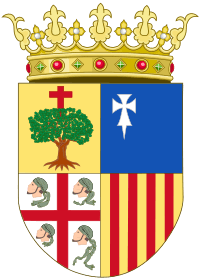Coat of arms of Aragon
The coat of arms of Aragon (Spanish: Escudo de Aragón; Aragonese: Escudo d'Aragón; Catalan: Escut de l'Aragó) was first chronicled in 1499 by Pablo Hurus. The coat displays Aragon through the years from its establishment to their monarchy and is made up of four shields:
| Coat of arms of Aragon | |
|---|---|
 | |
| Armiger | Aragon |
| Adopted | 1499 (earliest) |
| Crest | Aragonese Open Royal Crown |
| Blazon | Quarterly: 1 Sobrarbe, 2 Cross of Íñigo Arista (Primitive Aragon) 3 Cross of Alcoraz, and 4 Royal Bars of Aragon |
First quarter: The Sobrarbe tree or the Ainsa shield represents the legendary Kingdom of Sobrarbe and the establishment of Aragonese liberty.
Second quarter: The Cross of Íñigo Arista represents the Pyrenees and the old Aragonese monarchy.
Third quarter: The St George's Cross with four severed Moors' heads represents the conquest as Aragon extended into the plains, with tradition stating that the saint helped the Aragonese in the battle. This quarter inspired the coat of arms and flag of Sardinia since Aragon ruled Sardinia from in the 14th and 15th centuries.[1]
Fourth quarter: The Bars of Aragon represents the familiar coat of the Kings of Aragon that took over all territories within the Crown of Aragon[2].
See also
- Flag of Aragon
- Coat of arms of the Crown of Aragon
References
- http://www.sardegna.com/en/blog/meaning-sardinia-flag/
- "Archived copy". Archived from the original on 2013-06-11. Retrieved 2013-06-28.CS1 maint: archived copy as title (link)